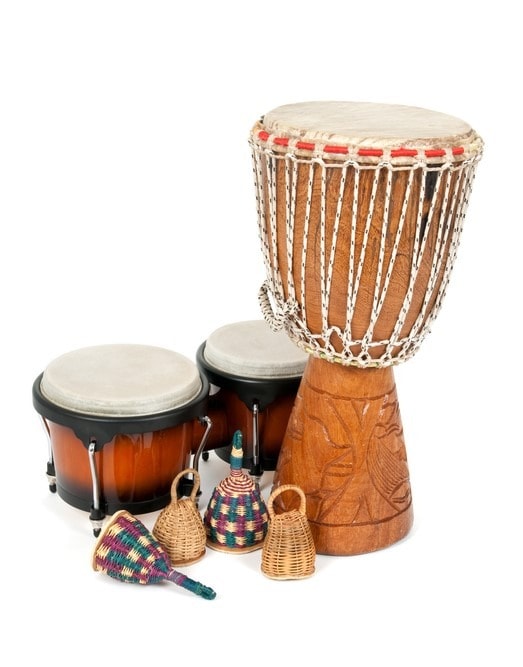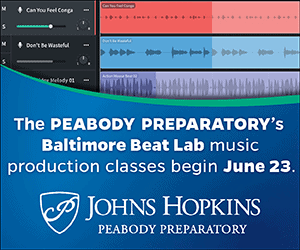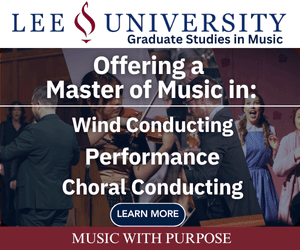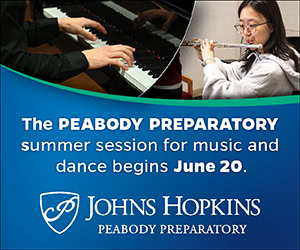/ News Posts / Developing Our Musicianship as Music Educators
Developing Our Musicianship as Music Educators
By NAfME Member Christopher H. Fashun, Assistant Professor of Music, Hope College
Christopher H. Fashun presented on “Afro-Brazilian Drumming for K–8 General Music” during the NAfME 2021 PreK–12 Learning Collaborative in February 2021.
As music educators, how do we continue to grow and develop our own musicianship with the demands of our music programs, teaching responsibilities, and administrative tasks during the academic year? As a music educator who taught middle and high school band and orchestra, I found that I had to create ways that I could maintain and develop my musicianship in and out of the classroom. Now, as a professor of music in higher education, I conduct and lead the orchestra program, teach instrumental music education methods courses and applied percussion, direct western and world percussion ensembles, and teach world music courses. Finding ways to continue to grow as a musician is an ongoing challenge.
In my 20+ years of being a music educator, I’ve discovered ways of maximizing my time with the goal of developing my own musicianship both in and out of the classroom using the music that I’m currently teaching. In this post, I’ll be sharing a few of the techniques I use in connection with the session I presented at the 2021 NAfME PreK-12 Learning Collaborative titled “Afro-Brazilian Drumming for K-8 General Music.”
For me, keeping my ear training, rhythmic skills, and expressive gestures honed is essential. In preparation for conferences and workshops, I systematically prepare the songs and rhythms that I present so that I can demonstrate for the participants. Synthesizing singing, playing, and moving are all skills I need and apply in my work as an orchestral conductor, performing artist, and educator.
Here is the progression I use to learn the Afro-Brazilian songs and rhythms. These are the same techniques I use to prepare for teaching and leading my rehearsals with my Brazilian Drumming Ensemble at Hope College. Let’s use the Candomblé song Moro mi má, which is the first song I presented in my session. You can watch my 2021 session here (I’ve provided specific timings for each technique from my session).
Here is the Moro mi má score.
- Learn the song (13:10-14:15)
- Sight read the song on la or any vocable.
- Practice the language pronunciation.
- Sing the song with the language.
- Learn the bell (gá/agogô) pattern.
- Sing the song while playing the bell pattern.
- Learn each atabaque (drum) part starting with the Lê (the highest drum), then the Rumpi (middle drum), and the Rum (lowest drum) (14:15-17:20).
- Sing the song with each atabaque (drum) part.
In my session, I also include movements (taught by my wife Jessica Fashun who is a vocal music educator of 20+ years) that accompany the song (10:30-12:50). I believe moving musically and expressively are necessary skills not only for the development of our musicianship, but for our students as well.
Using the same approach as I do with the music and instrumental parts, I do the same for the movements.
Lastly, learn each movement while singing the song. The way we’ve presented the “dance” is an interpretation of some of the movements used in Candomblé. For your classroom, you can adapt or select specific movements for your classroom.
Dance movements (5:00-9:30 due to technical issues the audio is very quiet in this segment).
- Sing the song while doing the basic “samba step” (side step-touch).
- Add the bell pattern (now you’re singing, playing, and moving).
- Play each atabaque part while singing and doing the samba step.
Entire song (17:20-20:45)
What do these different approaches do for our musicianship? Singing, playing, and moving simultaneously are the epitome of right brain-left brain independence. No matter what our music classroom (general music, band, orchestra, choir), we need to develop this independence to effectively lead our students through a lesson or rehearsal and in order to model creative possibilities.
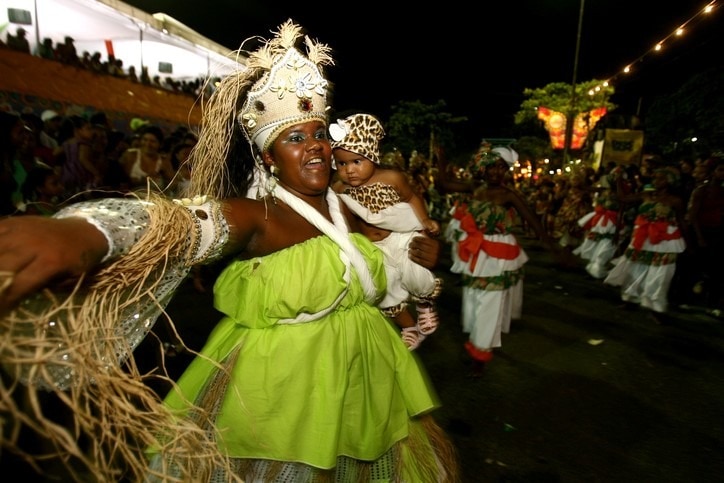
ilheus, bahia, brazil – february 21, 2012: members of the Afro Guerreiro de Zulu block are seen during a performance at the carnival in the city of Ilheus, in southern Bahia. iStockphoto.com | Joa_Souza
From a cultural standpoint, teaching music using the traditional Western pedagogical method that extracts and compartmentalizes moving, singing, and playing limits the development of synthesis of singing, playing, and moving. In contrast, most non-Western cultures sing, play, and move and think of them as one act or art form, not three separate elements. Because music, dance, and song are communal and part of everyday life where members of the community are active participants in their music culture, the music (singing, playing, moving) is learned from birth which perpetuates the music culture traditions of a group of people through the aural-oral tradition.
When can we practice these musicianship techniques? Anytime, anywhere. As I go through a teaching day, I choose a song I’m learning and sing, play, and move when I’m between classes, rehearsals, or lessons. Even if I have 5 minutes or I’m walking from my studio to the rehearsal room, I’m singing a song and tapping a rhythm on the move. When I’m driving, I’ll sing and tap the rhythms for each percussion part.
The other thing I’ve found invaluable as part of this process is listening to the music I’m studying. I create playlists of the different genres I am preparing and take time every day to listen to music. Sometimes I listen with intention and focus, other times it is for enjoyment, but I’m listening to the same playlist.
I’ve discovered that exercising these musicianship muscles frequently throughout the day has not only improved my ear training, sense of internal rhythm, and right-left brain independence, but also have created a habit of embodying and living the music that I’m teaching.
Resources:
Candomblé History, Songs, Terms, and Instruments
About the author:
 Dr. Christopher H. Fashun is an incredibly diverse and versatile conductor, performing artist, and music educator. He brings over two decades of experience leading collegiate, high school, and middle school orchestra and band programs in addition to presenting sessions on Brazilian music and culture for general music at national and state music education conferences and workshops.
Dr. Christopher H. Fashun is an incredibly diverse and versatile conductor, performing artist, and music educator. He brings over two decades of experience leading collegiate, high school, and middle school orchestra and band programs in addition to presenting sessions on Brazilian music and culture for general music at national and state music education conferences and workshops.
A 2019 recipient of a U.S. Postdoctoral Fulbright Award in All Disciplines, Dr. Fashun lived in Salvador da Bahia, Brazil, researching Afro-Brazilian music and culture in Brazil.
An Assistant Professor of Music at Hope College, he serves as the Director of Orchestras, is the founder and Music Director of the Brazilian Drumming Ensemble, teaches applied percussion, world music courses, and is an instructor of Instrumental Music Education. He is active in the Holland music community and serves as the Music Director and conductor of the Holland Area Youth Symphony Orchestra.
An accomplished percussionist and violist, he has several years of orchestral and chamber music experience and has enjoyed success in both areas as a soloist by winning three concerto competitions, one on viola and two on marimba. As a percussionist, he has toured and performed in Brazil, Thailand, Northern Ireland, Mexico, Brazil, and the United States.
Most recently, he arranged a Brazilian choro and Afro-Cuban piece for orchestra and percussion that will be available for purchase later this year.
Dr. Fashun is available for workshops or clinics in-person or virtually. For booking a workshop or clinic, mail chfashun@yahoo.com.
Did this blog spur new ideas for your music program? Share them on Amplify! Interested in reprinting this article? Please review the reprint guidelines.
The National Association for Music Education (NAfME) provides a number of forums for the sharing of information and opinion, including blogs and postings on our website, articles and columns in our magazines and journals, and postings to our Amplify member portal. Unless specifically noted, the views expressed in these media do not necessarily represent the policy or views of the Association, its officers, or its employees.
June 4, 2021. © National Association for Music Education (NAfME.org)
Published Date
June 4, 2021
Category
- Lifelong Learning
- Repertoire
Copyright
June 4, 2021. © National Association for Music Education (NAfME.org)

